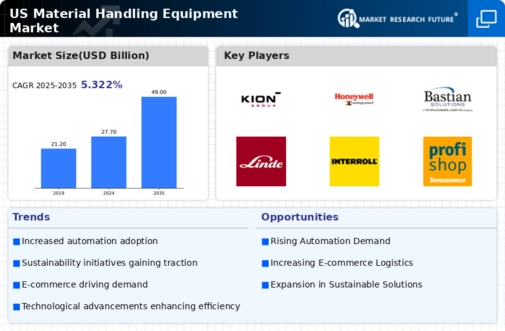Labor Shortages
Labor shortages in the US are significantly influencing the material handling-equipment market. With an increasing number of industries facing difficulties in hiring skilled workers, companies are turning to automation and advanced equipment to mitigate the impact of these shortages. The material handling-equipment market is witnessing a shift towards automated solutions, such as robotic systems and automated storage and retrieval systems, which can operate with minimal human intervention. This trend is expected to drive market growth, as businesses invest in technology to maintain productivity levels. In 2025, it is estimated that the demand for automated material handling solutions will increase by approximately 25%, reflecting the urgent need for efficient operations in the face of labor challenges.
E-commerce Growth
The rapid expansion of e-commerce in the US has a profound impact on the material handling-equipment market. As online shopping continues to gain traction, warehouses and distribution centers are increasingly investing in advanced material handling solutions to enhance efficiency and speed. In 2025, e-commerce sales are projected to reach approximately $1 trillion, necessitating the adoption of automated systems and equipment to manage the growing volume of orders. This trend drives demand for various material handling equipment, including conveyors, automated guided vehicles, and pallet jacks, as businesses strive to optimize their supply chains and meet customer expectations. Consequently, the is likely to experience robust growth. as companies seek to streamline operations and reduce delivery times.
Regulatory Compliance
Regulatory compliance is becoming increasingly critical for businesses operating in the material handling-equipment market. Stricter safety regulations and environmental standards are prompting companies to invest in equipment that meets these requirements. In 2025, it is anticipated that the market will see a surge in demand for equipment designed with safety features and energy-efficient technologies. This shift not only helps companies comply with regulations but also enhances their reputation and operational efficiency. As organizations prioritize compliance, the material handling-equipment market is likely to expand, driven by the need for safer and more sustainable solutions.
Supply Chain Resilience
The need for supply chain resilience is a driving force in the material handling-equipment market. Recent disruptions have highlighted the importance of robust supply chains, prompting companies to invest in equipment that enhances flexibility and adaptability. In 2025, the market is expected to grow as businesses seek to implement solutions that allow for quick adjustments to changing demands. This includes investing in versatile material handling equipment that can accommodate various products and workflows. As organizations focus on building resilient supply chains, the material handling-equipment market is likely to benefit from increased investments in innovative solutions that support operational agility.
Technological Advancements
Technological advancements are reshaping the material handling-equipment market, as innovations in equipment design and functionality enhance operational efficiency. The integration of Internet of Things (IoT) technology into material handling systems allows for real-time monitoring and data analysis, enabling companies to optimize their logistics processes. In 2025, the market for smart material handling equipment is projected to grow by 30%, driven by the increasing need for data-driven decision-making and improved supply chain visibility. As businesses adopt these advanced technologies, they are likely to experience reduced operational costs and increased productivity, further propelling the growth of the material handling-equipment market.























Leave a Comment